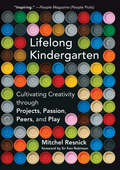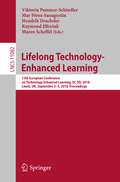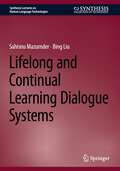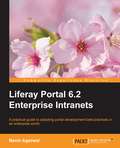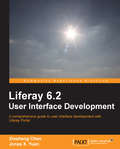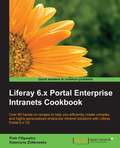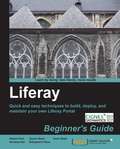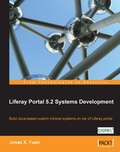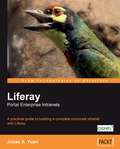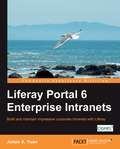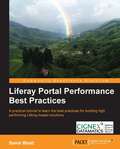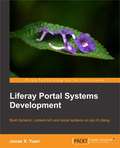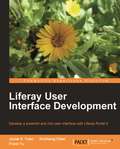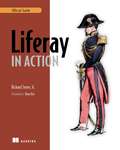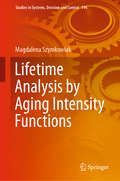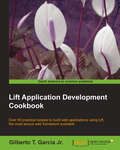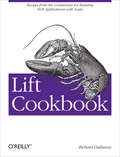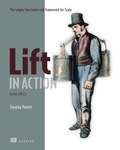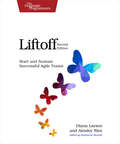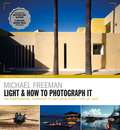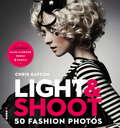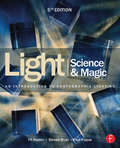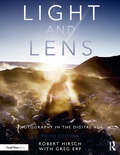- Table View
- List View
Lifelong Kindergarten: Cultivating Creativity through Projects, Passion, Peers, and Play (The\mit Press Ser.)
by Mitchel ResnickHow lessons from kindergarten can help everyone develop the creative thinking skills needed to thrive in today's society.In kindergartens these days, children spend more time with math worksheets and phonics flashcards than building blocks and finger paint. Kindergarten is becoming more like the rest of school. In Lifelong Kindergarten, learning expert Mitchel Resnick argues for exactly the opposite: the rest of school (even the rest of life) should be more like kindergarten. To thrive in today's fast-changing world, people of all ages must learn to think and act creatively—and the best way to do that is by focusing more on imagining, creating, playing, sharing, and reflecting, just as children do in traditional kindergartens.Drawing on experiences from more than thirty years at MIT's Media Lab, Resnick discusses new technologies and strategies for engaging young people in creative learning experiences. He tells stories of how children are programming their own games, stories, and inventions (for example, a diary security system, created by a twelve-year-old girl), and collaborating through remixing, crowdsourcing, and large-scale group projects (such as a Halloween-themed game called Night at Dreary Castle, produced by more than twenty kids scattered around the world). By providing young people with opportunities to work on projects, based on their passions, in collaboration with peers, in a playful spirit, we can help them prepare for a world where creative thinking is more important than ever before.
Lifelong Technology-Enhanced Learning: 13th European Conference on Technology Enhanced Learning, EC-TEL 2018, Leeds, UK, September 3-5, 2018, Proceedings (Lecture Notes in Computer Science #11082)
by Hendrik Drachsler Mar Pérez-Sanagustín Viktoria Pammer-Schindler Raymond Elferink Maren ScheffelThis book constitutes the proceedings of the 13th European Conference on Technology Enhanced Learning, EC-TEL 2018, held in Leeds, UK, in September 2018.The 42 full and short papers, 7 demo papers, and 23 poster papers presented in this volume were carefully reviewed and selected from 142 submissions. This year, the European Conference on Technology-Enhanced Learning (EC-TEL) will engage researchers, practitioners, educational developers, entrepreneurs and policy makers in a joint discussion on how to put science, technology and practice at the service of learning to embrace these challenges on the topic: Lifelong technology enhanced learning: Dealing with the complexity of 21st century challenges. Chapter "" is available open access under a Creative Commons Attribution 4.0 International License via link.springer.com.
Lifelong and Continual Learning Dialogue Systems (Synthesis Lectures on Human Language Technologies)
by Bing Liu Sahisnu MazumderThis book introduces the new paradigm of lifelong and continual learning dialogue systems to endow dialogue systems with the ability to learn continually by themselves through their own self-initiated interactions with their users and the working environments. The authors present the latest developments and techniques for building such continual learning dialogue systems. The book explains how these developments allow systems to continuously learn new language expressions, lexical and factual knowledge, and conversational skills through interactions and dialogues. Additionally, the book covers techniques to acquire new training examples for learning new tasks during the conversation. The book also reviews existing work on lifelong learning and discusses areas for future research.
Liferay 6.2 Intranet Portal Development Guide
by Navin AgarwalThis book is for anyone who is interested in the Liferay Intranet Portal. This book is for both beginners and more experienced portal developers who need to create an enterprise intranet portal for their business. It will be handy for IT professionals who know the basics of how the portal technology works and need to integrate different open source technologies.
Liferay 6.2 User Interface Development
by Xinsheng Chen Jonas X. YuanA step-by-step tutorial, targeting the Liferay 6.2 version. This book takes a step-by-step approach to customizing the look and feel of your website, and shows you how to build a great looking user interface as well."Liferay 6.2 User Interface Development" is for anyone who is interested in the Liferay Portal. It contains text that explicitly introduces you to the Liferay Portal. You will benefit most from this book if you have Java programming experience and have coded servlets or JavaServer Pages before. Experienced Liferay portal developers will also find this book useful because it explains the latest technologies used in the Liferay Portal. This book is a good reference for Liferay architects as the book also explains different technologies for portlet development and their strong and weak points.
Liferay 6.x Portal Enterprise Intranets Cookbook
by Piotr Filipowicz Katarzyna ZiolkowskaIf you are a Java developer or administrator with a technical background and want to install and configure Liferay Portal as an enterprise intranet, this is the book for you. In short, reusable recipes help you realize business goals as working features in Liferay. This book will also give you useful hints on how to easily improve the default functionality of the system and its performance.
Liferay Beginner’s Guide
by Sandeep Nair Robert ChenPart of Packt's Beginner's Guide series, each chapter follows the creation of a fictional neighbourhood site to demonstrate an aspect of Liferay portal with practical examples, screenshots, and step-by-step instructions. All you need in order to benefit from the Liferay Beginner's Guide is programming experience. No prior knowledge of Liferay is required, although experienced Liferay portal programmers who need to get up to speed with its latest features will also find this book useful.
Liferay Portal 5.2 Systems Development
by Jonas X. YuanThis book focuses on teaching by example. Every chapter provides an overview, and then dives right into hands-on examples so you can see and play with the solution in your own environment. All code samples run on both the latest Enterprise and Community releases. This book will be most useful to professional Java developers who want to build custom web sites, portals, and highly customized intranet applications using Liferay portal as a framework. This book is for Java developers, and you will get most from the book if you already work with Java but you need not have prior experience on Liferay portal. Although Liferay portal makes heavy use of open source frameworks such as Spring, Hibernate, Struts, and Lucene, no prior experience using these is assumed.
Liferay Portal Enterprise Intranets
by Jonas X. YuanThis book is a practical guide with a very user-friendly approach. The author has taken a virtual enterprise as an example and has used the features of Liferay to build a corporate intranet for that enterprise. This book is for System Administrators or experienced users (not necessarily programmers) who want to install and use Liferay in their teams or businesses without dealing with complex code. Pre-knowledge of Liferay is not expected for this book.
Liferay Portal Enterprise Intranets
by Jonas X. YuanThis book is a practical guide with a very user-friendly approach. The author has taken a virtual enterprise as an example and has used the features of Liferay to build a corporate intranet for that enterprise. This book is for System Administrators or experienced users (not necessarily programmers) who want to install and use Liferay in their teams or businesses without dealing with complex code. Pre-knowledge of Liferay is not expected for this book.
Liferay Portal Performance Best Practices
by Samir BhattA step-by-step tutorial on implementing Liferay- based portals to learn performance best practices.The book is good for Liferay portal developers and architects who want to learn performance best practices for implementing Liferay- based solutions. It is assumed that you have a working knowledge of the Liferay portal.
Liferay Portal Systems Development
by Jonas X. YuanThis book focuses on teaching by example. Every chapter provides an overview, and then dives right into hands-on examples so you can see and play with the solution in your own environment. This book is for Java developers who don't need any prior experience with Liferay portal. Although Liferay portal makes heavy use of open source frameworks, no prior experience of using these is assumed.
Liferay User Interface Development
by Xinsheng Chen Jonas X. YuanThis is a basic tutorial that teaches you how to use the tools provided by Liferay to create your own applications. It covers a lot of the material that has API references and documentation of the architecture and illustrates its key concepts with examples.If you have basic knowledge of Java Web applications, know the basic operational functionality of Liferay, and have written a servlet or JSP file, you are ready to get the most out of this book. Whether you are a web portal engineer or an experienced Liferay Portal developer, you can benefit from this book. You are not expected to have prior knowledge of Liferay theming.
Liferay in Action: The Official Guide to Liferay Portal Development
by Rich SezovSummaryLiferay in Action is a comprehensive and authoritative guide to building portals on the Liferay 6 platform. Fully supported and authorized by Liferay, this book guides you smoothly from your first exposure to Liferay through the crucial day-to-day tasks of building and maintaining an enterprise portal that works well within your existing IT infrastructure.About the TechnologyA portal is a website built around a collection of components that request, display, and share information. Liferay Portal 6, an enterprise-ready development platform, makes it a snap to build portals that integrate with your existing backend systems and provide a rich interactive user experience. Because Liferay uses standard Java and JavaScript, along with built-in SOAP and JSON support for web services, developers can be productive immediately. And since it's available in both a free, open source version as well as a fully-supported commercial edition, it's an affordable solution for almost any business or organizationAbout the BookLiferay in Action is the official guide to building Liferay portal applications using Java and JavaScript. If you've never used Liferay before, don't worry. This book starts with the basics: setting up your development environment and creating a working portal. Then, it builds on that foundation to help you discover social features, tagging, ratings, and more. You'll also explore the Portlet 2.0 API, and learn to create custom themes and reusable templates.Experienced developers will learn how to use new Liferay APIs to build social and collaborative sites, use the message bus and workflow, implement indexing and search, and more. This book was developed in close collaboration with Liferay engineers, so it answers the right questions, and answers them in depth.No experience with Liferay or the Portlets API is required, but basic knowledge of Java and web technology is assumed. Purchase of the print book comes with an offer of a free PDF, ePub, and Kindle eBook from Manning. Also available is all code from the book. What's InsideComplete coverage of Liferay Portal 6Covers both the commercial and open source versionsCustom portlet development using the Portlet 2.0 specLiferay's social network APIAdd functionality with hooks and Ext plugins======================================Table of ContentsPART 1 WORKING WITH LIFERAY AND PORTLETSThe Liferay differenceGetting started with the Liferay development platformPART 2 WRITING APPLICATIONS ON LIFERAY'S PLATFORMA data-driven portlet made easyMVC the Liferay wayDesigning your site with themes and layout templatesMaking your site socialEnabling user collaborationPART 3 CUSTOMIZING LIFERAYHooksExtending Liferay effectivelyA tour of Liferay APIs
Lifetime Analysis by Aging Intensity Functions (Studies in Systems, Decision and Control #196)
by Magdalena SzymkowiakThis book addresses a range of aging intensity functions, which make it possible to measure and compare aging trends for lifetime random variables. Moreover, they can be used for the characterization of lifetime distributions, also with bounded support. Stochastic orders based on the aging intensities, and their connections with some other orders, are also discussed. To demonstrate the applicability of aging intensity in reliability practice, the book analyzes both real and generated data. The estimated, properly chosen, aging intensity function is mainly recommended to identify data’s lifetime distribution, and secondly, to estimate some of the parameters of the identified distribution. Both reliability researchers and practitioners will find the book a valuable guide and source of inspiration.
Lift Application Development Cookbook
by Gilberto T. Garcia Jr.Lift Application Development Cookbook contains practical recipes on everything you will need to create secure web applications using this amazing framework.The book first teaches you basic topics such as starting a new application and gradually moves on to teach you advanced topics to achieve a certain task. Then, it explains every step in detail so that you can build your knowledge about how things work.This book is for developers who have at least some basic knowledge about Scala and who are looking for a functional, secure, and modern web framework. Prior experience with HTML and JavaScript is assumed.
Lift Cookbook: Recipes from the Community for Building Web Applications with Scala
by Richard DallawayIf you need help building web applications with the Lift framework, this cookbook provides scores of concise, ready-to-use code solutions. You’ll find recipes for everything from setting up a coding environment to creating REST web services and deploying your application to production.Built on top of the Scala JVM programming language, Lift takes a different—yet ultimately easier—approach to development than MVC frameworks such as Rails. Each recipe in this book includes a discussion of how and why each solution works, not only to help you complete the task at hand, but also to illustrate how Lift works.Set up an environment and run your first Lift applicationGenerate HTML, using Lift’s View First approachSubmit forms and work with form elementsBuild REST web services with the framework’s RestHelper traitTake advantage of Lift’s support for Ajax and CometGet examples for modifying Lift’s request pipelineConvert Scala classes into tables, rows, and columns in a relational databaseSend email, call URLs, and schedule tasks from your applicationPackage and deploy your application to various hosted services
Lift in Action: The Simply Functional Web Framework for Scala
by Tim PerrettSummaryLift in Action is a step-by-step exploration of the Lift framework. It moves through the subject quickly using carefully crafted, well-explained examples that make you comfortable from the start. This book is written for developers who are new to both Scala and Lift.About the TechnologyLift is a Scala-based web framework designed for extremely interactive and engaging web applications. It's highly scalable, production-ready, and will run in any servlet container. And Lift's convention-over-configuration approach lets you avoid needless work.About this BookLift in Action is a step-by-step exploration of the Lift framework. It moves through the subject quickly using carefully crafted, well-explained examples that make you comfortable from the start. You'll follow an entertaining Travel Auction application that covers the core concepts and shows up architectural and development strategies. Handy appendixes offer a Scala crash course and guidance for setting up a good coding environment. This book is written for developers who are new to both Scala and Lift and covers just enough Scala to get you started. Purchase of the print book comes with an offer of a free PDF, ePub, and Kindle eBook from Manning. Also available is all code from the book. What's InsideComplete coverage of the Lift frameworkSecurity, maintainability, and performanceIntegration and scalingCovers Lift 2.xTable of ContentsPART 1 GETTING STARTEDIntroducing LiftHello LiftPART 2 APPLICATION TUTORIALThe auction applicationCustomers, auctions, and biddingShopping basket and checkoutPART 3 LIFT IN DETAILCommon tasks with Lift WebKitSiteMap and access controlHTTP in LiftAJAX, wiring, and CometPersistence with MapperPersistence with Record
Liftoff: Start and Sustain Successful Agile Teams
by Diana Larsen Ainsley NiesReady, set, liftoff! Align your team to one purpose: successful delivery. Learn new insights and techniques for starting projects and teams the right way, with expanded concepts for planning, organizing, and conducting liftoff meetings. Real-life stories illustrate how others have effectively started (or restarted) their teams and projects. Master coaches Diana Larsen and Ainsley Nies have successfully "lifted off" numerous agile projects worldwide. Are you ready for success?Every team needs a great start. If you're a business or product leader, team coach or agile practice lead, project or program manager, you'll gain strategic and tactical benefits from liftoffs.Discover new step-by-step instructions and techniques for boosting team performance in this second edition of Liftoft. Concrete examples from our practices show you how to get everyone on the same page from the start as you form the team. You'll find pointers for refocusing an effort that's gone off in the weeds, and practices for working with teams as complex systems. See how to scale liftoffs for multiple teams across the enterprise, address the three key elements for collaborative team chartering, establish the optimal conditions for learning and improvement, and apply the GEFN (Good Enough for Now) rule for efficient liftoffs. Throughout the book are stories from real-life teams lifting off, as seasoned coaches describe their experiences with liftoffs and agile team chartering.Focused conversations help the team align, form, and build enough trust for collaborating. You'll build a common understanding of the teams' context within business goals. Every liftoff is unique, but success is common!
Light & How to Photograph It: The Professional Approach To Capturing Every Type Of Light
by Michael FreemanFor professional photographers, chasing the light, waiting for it, sometimes helping it, and finally capturing it is a constant preoccupation and for some, an obsession. Drawing on four decades of working with light, Michael Freeman takes a simple but practical approach to interpreting, reacting to, and capturing photography's most valuable commodity.Practical advice is organised into three straightforward sections: Waiting, Chasing, and Helping. Begin by mastering the art of patience, and recognise the immense value of anticipating and planning for gorgeous light that's just over the horizon. Then learn the techniques to meet otherwise transient and fleeting lighting conditions halfway, with quick thinking and fast reactions. Finally, make the most of the tools at your disposal to enhance and manipulate light as you find it, covering everything from in-the-field shooting choices to technical transformations in post-production. This is the method of a working professional - to interpret, approach, and master whatever lighting situation is thrown at you and always get the shot, no matter what.
Light & How to Photograph It: The Professional Approach To Capturing Every Type Of Light
by Michael FreemanFor professional photographers, chasing the light, waiting for it, sometimes helping it, and finally capturing it is a constant preoccupation and for some, an obsession. Drawing on four decades of working with light, Michael Freeman takes a simple but practical approach to interpreting, reacting to, and capturing photography's most valuable commodity.Practical advice is organised into three straightforward sections: Waiting, Chasing, and Helping. Begin by mastering the art of patience, and recognise the immense value of anticipating and planning for gorgeous light that's just over the horizon. Then learn the techniques to meet otherwise transient and fleeting lighting conditions halfway, with quick thinking and fast reactions. Finally, make the most of the tools at your disposal to enhance and manipulate light as you find it, covering everything from in-the-field shooting choices to technical transformations in post-production. This is the method of a working professional - to interpret, approach, and master whatever lighting situation is thrown at you and always get the shot, no matter what.
Light & Shoot 50 Fashion Photos: 50 Fashion Photos
by Chris GatcumFashion photography has always called for the maximum creative variety, with a constant pressure for photographers to produce fresh, exciting work with complicated, considered lighting and location design. Whether you're starting out or have many years of experience, this book is an accessible and varied way to explore the genre and pick up new ideas.Each of the 50 fashion photographs is accompanied by complete details on how it was achieved with insights from the photographer, alongside a detailed 3D lighting diagram showing where all the equipment and props were placed. Armed with all this detail, it's easy to see how photos were made, learn how to use equipment, and develop as a photographer.There is also an introduction to camera and lighting equipment, and a complete glossary of terminology.
Light Science & Magic: An Introduction to Photographic Lighting
by Steven Biver Fil Hunter Paul FuquaPhotographic lighting is a topic that will never go out of style, no matter how sophisticated cameras and other technology get. Even with the most high-tech gear, photographers still need to put a lot of thought and vision into lighting their photographs in order to get great results. This key skill has the power to dramatically and quickly improve photographs. Light Science and Magic provides you with a comprehensive theory of the nature and principles of light, with examples and instructions for practical application. Featuring photographs, diagrams, and step-by-step instructions, this book speaks to photographers of varying levels. It provides invaluable information on how to light the most difficult subjects, such as surfaces, metal, glass, liquids, extremes (black-on-black and white-on-white), and portraits. This new edition includes: All new chapter titled "Setting Up Your New Studio" A re-vamped and expanded chapter 8 now titled "Making Portraits" New appendix of reliable photo gear sources Over 100 new photographs and informational sidebars Updated information about advances in flash equipment, LED panels and fluorescent lights Styles of lighting continue to change, but the nature of light will always remain the same. Once photographers understand the basic physics of lighting, they can apply that knowledge to a broad range of photographic styles.
Light and Lens
by Robert HirschLight & Lens: Photography in the Digital Age is a groundbreaking introductory book that clearly and concisely provides the instruction and building blocks necessary to create thought-provoking digitally based photographs. It is an adventurous idea book that features numerous classroom-tested assignments and exercises from leading photographic educators to encourage you to critically explore and make images from the photographers' eye, an aesthetic point of view. Acquire a basic foundation for digital photography. Light and Lens covers the fundamental concepts of image-making; how to use today's digital technology to create compelling images; and how to output and preserve images in the digital world.Explore the history, theory and methods of digital image-making. Light and Lens translates the enduring aesthetics of art photography into the digital realm. You'll view, capture and think about images from a new perspective.Increase your ability to analyze, discuss and write about your own work and the images of others.Learn with exercises and assignments by leading digital educators. Innovative techniques will train your eye to make the strongest visual statement.Solve visual problems and overcome image challenges. Whether you use a digital SLR or a point-and-shoot camera, you'll get new strategies to master composition, design and light. View the full range of the digital terrain with stunning images and commentary by over 190 international artists.Robert Hirsch is a renowned photographer, educator, historian and writer. His book credits include Photographic Possibilities: The Expressive Use of Ideas, Materials and Processes; Exploring Color Photography: From the Darkroom to the Digital Studio; and Seizing the Light: A History of Photography. He has had many one-person shows and curated numerous exhibitions. Hirsch has also conducted many workshops and interviewed eminent photographers of our time. The former executive director of CEPA Gallery, he is now the director of Light Research in Buffalo, New York, and on the Visual Studies faculty of University of Buffalo/The State University of New York.
Light and Lens: Photography in the Digital Age
by Robert HirschThe new edition of this pioneering book allows students to acquire an essential foundation for digital photography. Fully updated, it clearly and concisely covers the fundamental concepts of imagemaking, how to use digital technology to create compelling images, and how to output and preserve images in the digital world. Exploring history, methods, and theory, this text offers classroom-tested assignments and exercises from leading photographic educators, approaches for analyzing, discussing, and writing about photographs, and tools to critically explore and make images with increased visual literacy. New to this edition: • New larger page format • Revised and renewed to reflect technological advances • Expanded coverage of smartphone/mobile photography • Extended coverage of the careers section • More than 100 new images
